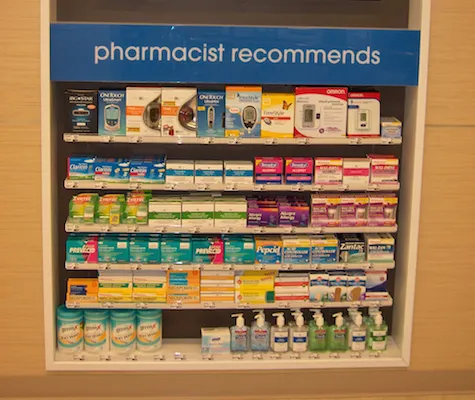It’s well known that when it comes to grocery shopping, the consumer is in charge, armed with the knowledge from manufacturer and retailer websites, online and offline advertising, and a tsunami of social media. The same is rapidly becoming true in day-to-day health care — i.e., self-care.
Robert Sanders, IRI
Greater access to over-the-counter health products and vitamin, mineral and supplements (VMS) products; increased awareness of preventions for chronic diseases; the rising cost of health care in general; and a heightened sense of empowerment and control over lifestyle and disease management are the key drivers to consumers’ self-care interest and engagement.
As consumers’ pursuit of personal health grows, the consumer health care industry has a golden opportunity to rethink and refresh the value proposition of O-T-C and VMS products and generate new interest from shoppers.
In late 2014 IRI, in partnership with the Consumer Health Care Products Association (CHPA), conducted a 360-degree, self-care study with about 5,000 self-care stakeholders, including consumers, health care professionals, retailers and managed care executives. The study’s goal was to generate a better understanding of how consumers perceive existing O-T-C and VMS products while identifying triggers that have the potential to accelerate industry growth.
IRI and CHPA’s findings provide an opportunity to create a dialogue with consumers and enhance their self-care perceptions and attitudes, thereby unlocking further O-T-C and VMS growth.
The report defines self-care as a set of empowerment actions in patients’ health and wellness management. Those actions include regular doctor consultations; lifestyle actions pertaining to diet and exercise and to O-T-C and VMS usage; prescription usage; alternative therapies and treatments; and in-home monitoring. Since self-care encompasses multiple facets of an individual’s health, O-T-Cs and VMS aren’t always top-of-mind as are other self-care components, such as diet, exercise, sleep and routine doctor’s visits.
There are abundant opportunities for manufacturers and retailers to effectively position O-T-Cs and VMS as more than just a supplemental way to bolster health and rather as a self-care necessity.
Consumers who regularly engage with O-T-Cs and VMS count an increased sense of empowerment and control of lifestyle and disease management as a purchase driver. These consumers tend to have a better perception of the benefits of these products, including cost and time savings.
While the IRI and CHPA data shows that more than half of survey respondents consider O-T-Cs effective, it also reveals that some consumers question whether the products have been thoroughly tested and whether they are critical to maintaining one’s health. What many consumers don’t know is that many O-T-Cs began as prescription products, which creates an opening for manufacturers and retailers to inform shoppers of a product’s efficacy.
The survey data suggests that a lack of trust in consumer health care products stems from conflicting data sources, competing O-T-C claims, product recalls, lack of physician support and pharmaceutical disclaimer advertising. Shifting consumers’ perceptions of O-T-Cs and VMS starts with providing a quality product and creating relationships within the health care industry. Manufacturers and retailers that engage in a fact-based, ongoing marketing campaign can sway negative perceptions into a positive recognition of the value of O-T-C and VMS products for eventual product adoption.
While self-care activity is highest among younger consumers, there is potential to expand among key older segments, who tend to trust prescription medicines more than O-T-Cs because of the chronic nature of their medical conditions. Many of the key older consumer segments that are the most wary of O-T-Cs and VMS lack the tools required to access information and educate themselves about the products.
Reducing confusion and increasing education and awareness among older consumers and their caregivers will help shift this key segment’s perception of O-T-Cs from an unknown element to a set of solutions that save time and money while keeping consumers in good health.
Opportunities for consumer health marketers
Convenience, greater control of health and cost savings are three key benefits to O-T-C usage cited by the IRI respondents. According to IRI data, nearly 50% of the consumer respondents indicated that co-pay affects their primary care doctor’s visits and whether they fill prescriptions.
This creates an opportunity for O-T-C manufacturers and retailers to leverage the convenience of O-T-Cs, cost savings, patient control and the variety of O-T-C options by building relationships with pharmacists, who can provide help at the point of sale. Since consumers are already focused on lifestyle changes, a greater health care provider emphasis on self-care through O-T-Cs and VMS will benefit both doctors and patients. Almost four out of five surveyed indicated that their doctor’s opinions influenced their O-T-C and VMS usage.
Doctors’ wary reception of O-T-Cs and VMS has created a significant obstacle to a higher level of adoption among consumers. Health care providers’ recommendations for O-T-Cs and VMS occur in fewer than 20% of patient visits, due in part to the lack of time available for each patient and a lack of quality information available to them.
Providing health care providers with easily accessible information will greatly decrease their time spent searching for O-T-C and VMS information, allowing them more time to suggest treatments and supplements with patients — solutions that are more convenient and affordable in most cases.
Pharmacists and primary care physicians in the IRI and CHPA survey responded that as many as 76% of their patients would be encouraged to utilize O-T-C products for self-treatment and self-care if there were better patient education methods for the health conditions they are currently managing and if patients better understood the benefits and uses of O-T-C products.
Promoting the cost differences of O-T-C products over prescription medications, more user-friendly tools, promotion through public health organizations and more O-T-C options in general for each condition are some of the other actions respondents mentioned for increasing the usage of O-T-C products for self-treatment and self-care.
Future of O-T-Cs and VMS
Unlocking further O-T-C and VMS growth via self-care will require effort from manufacturers, retailers, health care providers and consumers.
Educating consumers in collaboration with key stakeholders — including health care providers, managed care organizations and government entities — while leveraging the relationships between pharmacists and physicians with their patients are some of the first steps to building trust. Trust will require generating awareness of O-T-Cs’ safety and efficiency and a continued effort to switch major therapeutic categories.
A concerted industry effort is needed to increase the credibility of health information to drive proper selection and appropriate use of O-T-Cs and VMS. The changes that need to be made in order to build trust and knock down barriers for consumer health care products will take time, but can be accomplished through a joint effort.
The market potential to “get it right” is tremendous; indeed, manufacturers and retailers that can generate sales and market share uplift by activating consumers can do much for the self-care of their bottom lines. Consumer and retail empowerment are leading self-care manufacturers to a new place with countless opportunities, and maybe someday to the cure for the common cold.
Robert Sanders, executive vice president and health care practice leader at IRI, brings more than 30 years’ experience to the marketplace, sets the strategic initiatives for IRI’s home and health care practice, and is a frequent keynote speaker at health care industry events.









